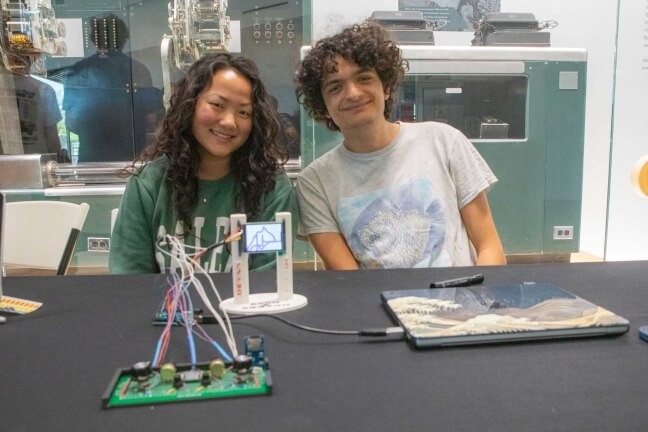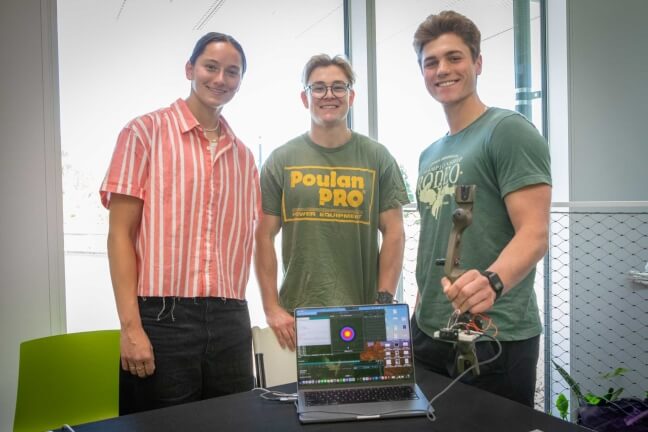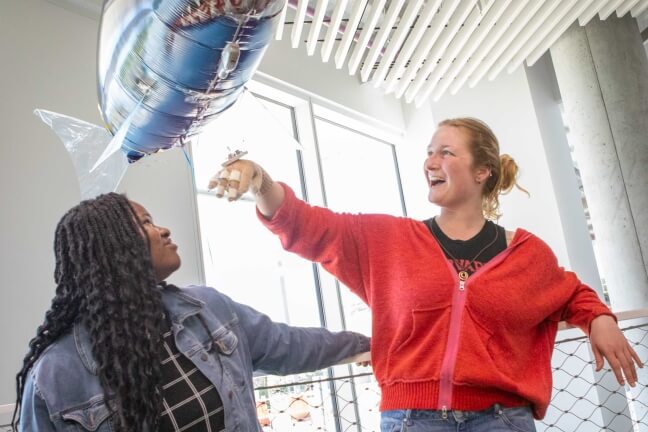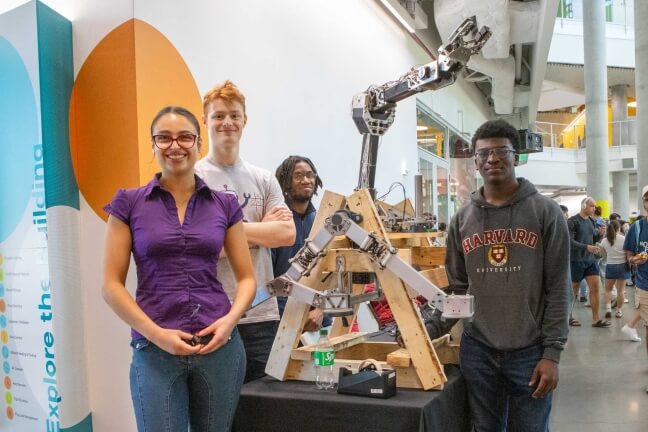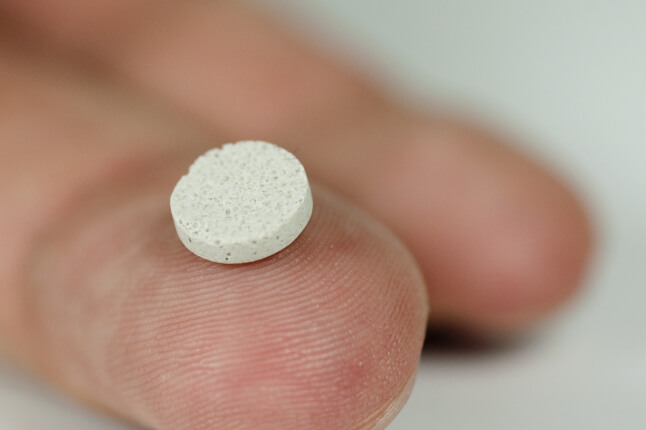News
Khang Nguyen plays "Guitar Hero" with "The Resistors," custom instruments he built with Jonathan Slohoda, Tanya Nuno, Kiara Solano and Nate Brown (Eliza Grinnell/SEAS)
A shark balloon that tips and turns with the flick of the wrist. A weightlifting bar that tells you if your form is good. A robot that plays Tic-Tac-Toe. A percussion instrument powered by muscle flexion. A wooden “Guitar Hero” controller that’s actually sturdier and more accurate than the original plastic instruments.
As the Design & Project Fair shows, when engineers get a chance to play, they come up with some truly innovative ideas.
“I think having a project where you have something fun at the end is always more gratifying,” said Genevieve Hill, who built an electronic Etch A Sketch. Her partner Devan Tatlow added, “We've been seeing all the projects as they're been coming together in the lab one by one, but we haven't seen them all together. So it's fun.”
The annual Design & Project Fair showcases final projects from many classes and student organizations at the Harvard John A. Paulson School of Engineering and Applied Sciences (SEAS). Visitors to the Science and Engineering Complex got to try out numerous games, gadgets and inventions at an event that feels like equal parts engineering exhibition and county fair.
Hill’s project was the final for “ES50: Introduction to Electrical Engineering,” which took up the entire east atrium of the Design & Project Fair. Each project drew on lessons throughout the semester, while also challenging students to develop new skills. Many of the projects also drew on students’ personal interests, alongside their academic pursuits.
Miriam Kim and Kodi Kim, both active powerlifters, designed the Lift Assist, which clamps onto a weightlifting bar and measures reps, stability and form.
“My partner and I, we actually became friends because we used to go to the gym together a lot,” said Miriam Kim. “We're both really into powerlifting, and I recently went to a powerlifting competition, and the thing about powerlifting competitions is that you have to perform without using a mirror. So you really have to know your form without being able to see yourself. So that's how we came up with this idea of a sensor-powered way of measuring how well you're doing with your form.”
"Lift Assist," by Miriam Kim and Kodi Kim (Eliza Grinnell/SEAS)
An electronic Etch A Sketch game, designed by Genevieve Hill, Devan Taylor and Roaa El-Fishawy (Eliza Grinnell/SEAS)
David Perez-Cruet wanted to combine his interest in mechanical engineering with his passion for archery, being co-captain of the Harvard Archery Club and a former bow mechanic at an archery company in his home state of Michigan. For their ES50 project, Perez-Cruet and partners Mike Kuhl and Chloe Bednar built E-Archery, a replica bow handle equipped with sensors that interfaces with a target on a computer screen to help archers improve their accuracy and form.
“We really enjoyed getting to work on this project and getting more experience just putting our skills to the test and getting to put them into this project that we made,” said Perez-Cruet. “Not always do archers have access to facilities where they can practice archery. You don't need to be able to shoot your bow to be able to use this training aid. So I think it's a very useful tool for archers to be able to practice.”
Harvard SEAS students explain the inspiration and impact behind their creations
E-Archery and Lift Assist weren’t the only ES50 projects designed to help with training or physical activity. Mus(I)cle, designed by Brooke Decho, Sean Callaghan, Ishika Nag and Peyton Hadfield, connected muscle flexion sensors to a mechanical array of colored tubes of varying lengths, an instrument known as a boomwhacker. By flexing their muscles, signals traveled through wires to the array, causing tubes to lower and strike a surface, emitting musical notes.
“Our motivation for creating this instrument was for students with different muscular disabilities,” said Hadfield. “In elementary school classes and things like that, it's difficult for people that don't have full range of motion to engage with musical instruments. This is one way that you're able to have everyone engage. We also think this could act as some sort of physical therapy tool, because as you get stronger, you can increase the muscular thresholds and continue to build your muscle strength, and you're able to play each note as just one person.”
"E-Archery," by Chloe Bednar, David Perez-Cruet and Mike Kuhl (Eliza Grinnell/SEAS)
Sara Thomas use The FINesse Glove in front of teammate Bekuochukwu Uzo-Menkiti (Eliza Grinnell/SEAS)
Right beside E-Archery, Bekuochukwu Uzo-Menkiti, Audrey Cherilyn and Sara Tomas stood in front of a helium-filled inflatable shark tied to a railing so it wouldn’t float away. Cherilyn wore a glove on her wrist, and by flexing and moving the glove, she could send infrared signals to a weight attached to a track along the underside of the inflatable. As the weight moved, the shark could move side to side or tip up and down. The team named their project The FINesse Glove.
“We just wanted something that was very sci-fi, since it's an ES50 final project,” Cherilyn said. “We wanted something very cool and we thought, oh, what's cooler than a flying shark that we can control with our hand?”
While ES50 projects filled the East Atrium, the West Atrium belonged to seniors showing off posters for their senior capstone projects. In between were tables for student organizations such as the Harvard Undergraduate Robotics Club (HURC). At the HURC table, club members hovered around a tall robot, its six wheels giving way to a wooden structure housing a robotic arm. The club is building a Mars rover for the University Rover Challenge, an annual robotics competition in Utah.
“Our team consists of mechanical, electrical software and science sub-teams, and we're always looking for more people to join,” said Jannah El-Rayess, a second-year mechanical engineering student and rover team founder. “We just want passion and commitment. Aside from making great friends, you'll get to learn a lot of super cool things about robots and make something super big and cool.”
The Harvard Undergraduate Rover Team, led by Jannah El-Rayess (Eliza Grinnell/SEAS)
Much smaller robots scooted around a playing field in the SEC’s lowest atrium. Turf Wars, the traditional final project for “ES51: Computer-Aided Machine Design,” challenged students to build robots capable of grasping small objects such as pucks or balls, then dropping them into a tic-tac-toe board in the center of the playing area. Each team designated one student to pilot the robot during matches using a remote control, and the teams competed in a double-elimination tournament.
“A lot of hours of work went into this thing,” said Spencer Doan, whose team, Robocop-out, won the championship. Doan was joined by Abdulaziz Sobirov, Moana Gorezi, Martha le Huray, Andreas Savva and Alex Miramontes Rodriguez. “To see it perform today was very satisfying.”
Robocop-out scores points and wins the 2025 Turf Wars. (Eliza Grinnell/SEAS)
Topics: Academics, Bioengineering, Design, Electrical Engineering, Environmental Science & Engineering, Events, Materials Science & Mechanical Engineering, Robotics, Student Organizations
Cutting-edge science delivered direct to your inbox.
Join the Harvard SEAS mailing list.
Press Contact
Matt Goisman | mgoisman@g.harvard.edu


